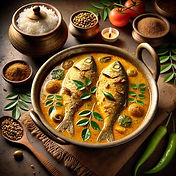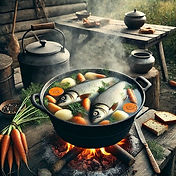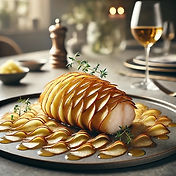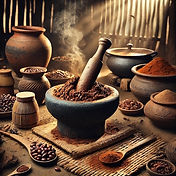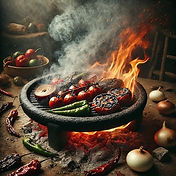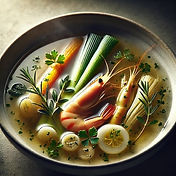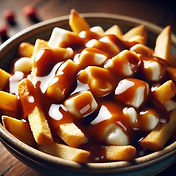Top Chef ™: Wisconsin
Season:
Week:
Lay it All on the Table

Kristen Kish: "Chefs, what does a crawfish boil, a kamayan and a grazing table all have in common?
Manny: "It's eaten on the table."
Kristen Kish: "There you go. They are types of meals that are served directly on tables without any plates. We want you to throw the norm out the window and think beyond the plate."
Kristen Kish: "There are fine dining chefs all over the world that are actually using the table to plate their food. For example you have Grant Achatz at Alinea creating desserts where guests literally eat off the table."
Kristen Kish: "For your elimination challenge, we want you to create a dish that is directly plated on a tabletop. Instead of giving us one great plate of food, give us one great table of food. Your creation can be sweet or savory as long as it all fits one tabletop. You'll be serving an intimate table of Gale, Tom, myself, and two Michelin starred chef and owner of Ever restaurant, Curtis Duffy."

Get recipes ...
Subscribe to our weekly recipes and culinary tips from streamed cooking shows.
Dishes prepared in
Top Chef ™: Wisconsin
Michelle: "I was definitely inspired by brunch today. So I did a play on gravadlax and bagels instead. I did cured salmon with beet biscuits. There's pickled beets with capers, and then there's a little egg with caviar and then a fig jam with bacon. And the chips are seasoned with beets and Cajun seasoning."
Judge: "Michelle, why did you choose to not use the whole table?"
Michelle: "I really just wanted you to be interactive with this. More importantly, time is tough."
Manny: "We have a squid ink risotto with crab, scallops, shrimp."
Judge: "It does smell great. Maybe this is risky - risotto on Top Chef, tableside right there?"
Manny: "Yeah. We have a Pesto Alla Trapanese. This one doesn't have cheese in it. It has sun dried tomatoes, colatura di Alici, and marcona almonds in it. The green oil is a basil. The red oil is Calabrian."
And what's this?
Just panko with butter, parsley, and lemon sauce.
Savannah: "I was inspired by the first course in a traditional Kaiseki cuisine, the zensai course. So the first bite is a kombu cured salmon nigiri with a little bit of wasabi. The second bite is shrimp tempura with a yuzu ponzu daikon gane. The third bite is a boiled and grilled octopus and then seared tuna with black garlic soy glaze. And then the last bite, a oyster with an aji murillo sauce, a champagne jelly, and caviar.
Dan: " I present you with beet tartar mixed with tahini, pickled apples, celery, and shallots. We have a beet puree with shirodashi and fish sauce, a fried kale and pumpkin seed puree with a little fried kale salad. We have some scallion powder. There's black garlic, lavender with harissa oil and horseradish emulsion. And then there's a side that is somewhere between a pita and a english muffin."
Gail Simmons, waving the side: "That's a perfect description."
Dan: " I call them puffins. I just had a good time with this."
Danny: "This is my version of a paella. I've got some black rice that's been tossed with a piquillo pepper puree. I saw this as a big canvas. Thought of Jean-Michel Basquiat, a lot of his work. He'll start and then paint over with black, which is basically where the black rice came into play. The border is several different purees. There's black garlic, there's zucchini, and then there's a creme fraiche, all to tie into everything on top."
Laura: "So I do have a lot of stuff."
Gail Simmons: "You're busy."
Laura (plating tableside): "I'm adding raspberries. Then I'll do a little bit of meringue just for crunch. And to me, everything comes together with a circle of the baklava."
Judge, exclaiming: "Oh, the ice creams are chewy."
Laura: "Ice cream. Yes, we've got Maras. Starting from the right, that's rose créme anglais, sauce of sour cherry, pistachio. And the last sauce is honey. So you break the baklava and use the shards to scoop the ice cream and sauces."
Kristen Kish: "Have you done anything like this before?"
Laura: "I never thought in my life that I would be doing something like this. I had so much fun."
Culinary Challenges inspired by
Top Chef ™: Wisconsin
Meen Moilee is a celebrated Kerala fish curry that exemplifies South Indian coastal cuisine. This luxurious dish features firm white fish gently poached in a velvety coconut milk sauce infused with aromatic spices. The preparation begins by sautéing curry leaves, green chilies, ginger, and onions until fragrant, then adding turmeric, ground spices, and coconut milk to create a golden, creamy base. The fish is carefully added last, allowing it to cook just until tender. The hallmark of Meen Moilee is its balanced flavor profile - mild heat complemented by tanginess from tomatoes or sometimes vinegar, sweetness from coconut milk, and brightness from fresh lime juice. Served with rice, this curry represents the perfect harmony of Kerala's abundant seafood and tropical ingredients.
Ukha is a traditional Russian clear fish broth that dates back centuries, revered for its clean, delicate flavors. This aromatic soup begins by gently simmering whole fish—typically freshwater varieties like pike, perch, or sturgeon—with minimal vegetables and aromatics, allowing the pure essence of the fish to shine through.
The preparation is deliberately simple: fish, onions, carrots, bay leaves, black peppercorns, and occasionally potatoes or leeks. What distinguishes ukha is its clarity—the broth should remain transparent, never cloudy. Often finished with fresh herbs like dill or parsley and a splash of vodka, authentic ukha embodies Russian cuisine's philosophy of highlighting natural flavors rather than masking them with excessive seasonings.
Pommes de terre en écailles, meaning "scaly potatoes" in French, is an elegant potato preparation technique that transforms the humble tuber into a sophisticated side dish. Thin-sliced rounds of peeled potatoes are meticulously arranged in overlapping patterns resembling fish scales or roof tiles in a buttered dish. Each layer is brushed with melted butter and seasoned with salt and pepper before the next is added. The assembled potatoes are then baked until the edges turn wonderfully crisp while the centers remain tender.
The result is a visually striking dish with beautiful textural contrast—crispy, golden exterior scales protecting creamy interiors—that elevates any meal with its refined presentation and rich buttery flavor.
Dawadawa is a traditional West African fermented seasoning made primarily from locust beans (Parkia biglobosa), though occasionally from soybeans or other legumes. The preparation begins by boiling the beans until soft, then pounding them to remove the seed coats. The cleaned seeds are boiled again, spread out, and covered with leaves to ferment naturally for 2-3 days. This fermentation process develops a pungent aroma and complex, umami-rich flavor profile. The resulting black paste is typically shaped into balls or patties for storage. Used as a flavor foundation in soups, stews, and sauces across Ghana, Nigeria, and other West African countries, dawadawa adds remarkable depth and nutritional value to countless dishes.
You can buy dawadawa spice here.
Pipian is a rich, traditional Mexican sauce that exemplifies the complexity of pre-Hispanic cuisine. Made from ground pumpkin or squash seeds (pepitas), this velvety sauce incorporates various chiles, spices, and sometimes nuts or seeds like sesame or peanuts. The ingredients are toasted, ground into a paste, and simmered with broth until thickened to a smooth consistency. Pipian can range from vibrant green (pipian verde) to deep red (pipian rojo), depending on the chiles used. Commonly served over poultry or pork, this sauce offers a nutty, earthy flavor profile with subtle heat that showcases Mexico's remarkable ability to balance complex flavors into harmonious dishes.
Tatemado is a traditional Mexican cooking technique most commonly associated with Jalisco cuisine. This slow-cooking method involves placing ingredients—typically meat such as pork, goat, or beef—into clay pots that are partially buried in hot coals or placed in an underground pit oven. The pots are sealed with masa (corn dough) to trap moisture and smoke, allowing the meat to cook gently for several hours until incredibly tender. This process imparts a distinctive earthy flavor while preserving the meat's natural juices.
Tatemado dishes are often seasoned with regional spices, chiles, and herbs, creating complex flavor profiles that showcase Mexico's rich culinary heritage. The result is meltingly tender meat with unparalleled depth of flavor.
Nage, pronounced "nahj," is a fragrant, aromatic broth used in French cuisine primarily for poaching seafood and vegetables. This delicate liquid is typically created by simmering wine, water, or fish stock with aromatic vegetables (onions, celery, fennel) and herbs. After cooking, the ingredients may be strained out, and the remaining liquid can be reduced and enriched with butter to create a "beurre monté" sauce.
The term 'nage' is also used to describe dishes cooked in this liquid—referred to as "à la nage"—resulting in light, flavorful preparations that highlight the natural taste of the main ingredient while infusing it with subtle complexity.
Poutine: Quebec's Beloved Comfort Food
Poutine is a Canadian culinary treasure originating from Quebec in the late 1950s. This hearty dish consists of three essential components: crispy french fries, cheese curds, and rich brown gravy poured generously over the top, creating a delicious mess of contrasting textures and flavors.
The magic of poutine lies in its seemingly simple yet perfectly balanced combination. When done right, the fries remain crisp on the outside while soaking up savory gravy. The cheese curds, which must be fresh to achieve their signature 'squeak' between your teeth, soften slightly from the heat without fully melting. The gravy ties everything together with its savory depth. It is basically a roux, traditionally thickened with chicken or beef stock but a vegetarian option is just as good, with flavor from umami-rich mushrooms or earthy beets.
To create authentic poutine at home, begin with freshly cut potatoes, twice-fried for optimal crispness - first at a lower temperature to cook through, then at a higher temperature for that golden exterior. The cheese curds should be room temperature and as fresh as possible. Their slightly tangy flavor and distinctive texture cannot be substituted with shredded cheese. For the gravy, create a flavorful stock reduction, thickened to a consistency that coats the back of a spoon without being gloopy.
Assembly requires careful timing. The fries must be piping hot from the fryer, immediately topped with curds and quickly covered with steaming gravy that's hot enough to warm the curds but not so hot it melts them completely.
While traditional poutine remains a beloved classic, modern variations might include toppings like pulled pork, smoked meat, or even lobster. Whether enjoyed from a roadside stand in rural Quebec or prepared in your kitchen, poutine represents comfort food at its finest. it is unpretentious, indulgent, and deeply satisfying.
Soba Cha (also known as Soba-Cha and Sobacha) is Japanese buckwheat tea. It is drunk hot or cold, and is gluten-free and caffeine-free and apparently tastes nutty and slightly sweet.
It appeared three times in Top Chef: Wisconsin ™. The first showing was in Restaurant Wars when Danny's team, under his leadership, served up cold Soba Cha as a welcome drink. It wasn't well received.
In reparation, Danny re-introduced it in week 12 when he infused mushrooms into Soba Cha for his fish dish. This time, the judges regretted that he had buried the flavor of the buckwheat tea in very powerful mushroom flavors and would have preferred the essence of the tea to shine through.
Danny didn't try again, but Dan used Soba Cha in his Smoked Dashi and this time it went down a storm.
Hummingbird cake is a Jamaican banana and pineapple spiced cake which has been eaten in the southern United States since the 1970s. It is a leavened cake with a salty cake and often contains pecans.
Mofongo is a Caribbean dish originating in Puerto Rico and the Dominican Republic. Made by mashing ripe plantains with fat, garlic, spices, and (optionally) pork crackling, it is then shaped into a ball. The dish is famous for its complex and contrasting textures, with fried plantains that are crispy on the outside and soft on the inside. It is often found topped with melted cheese and served with a clear garlic broth.
Danny, in the 'spoiler' for the Top Chef Wisconsin Finale, was heard to say that he wanted to get fresh scallops for his first course and treat them in the style of "Leche de Tigre".
Leche de tigre, (translates to tiger's milk), is the Peruvian term for a citrus marinade that cures fish or seafood. Also known as leche de pantera, this marinade usually contains lime juice, onion, chile, and fish sauce.







